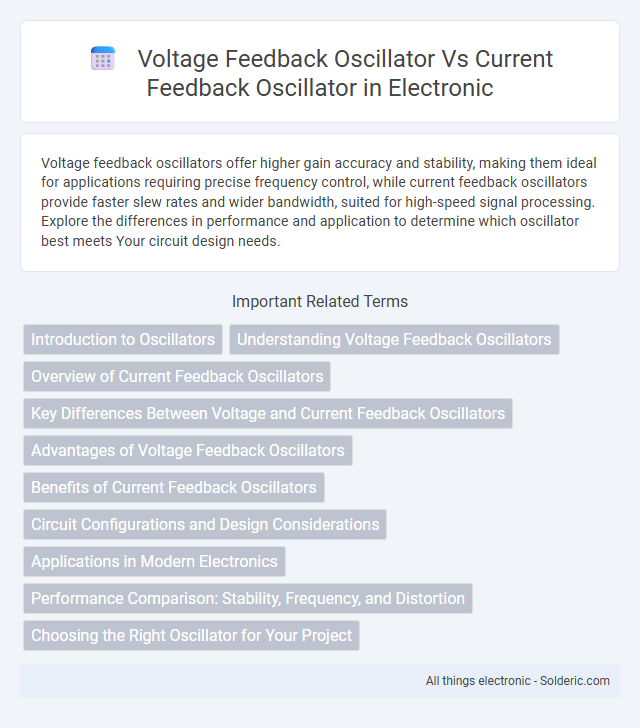Voltage feedback oscillators offer higher gain accuracy and stability, making them ideal for applications requiring precise frequency control, while current feedback oscillators provide faster slew rates and wider bandwidth, suited for high-speed signal processing. Explore the differences in performance and application to determine which oscillator best meets Your circuit design needs.
Comparison Table
| Feature | Voltage Feedback Oscillator (VFO) | Current Feedback Oscillator (CFO) |
|---|---|---|
| Feedback Type | Voltage feedback | Current feedback |
| Bandwidth | Narrower bandwidth | Wider bandwidth |
| Speed | Slower slew rate | Faster slew rate |
| Gain Stability | High gain stability | Gain varies with frequency |
| Output Swing | Limited output swing | Higher output voltage swing |
| Linearity | Better linearity | Lower linearity |
| Complexity | Simple design | More complex design |
| Common Applications | Low-frequency oscillators, precision circuits | High-frequency oscillators, video circuits |
| Noise Performance | Lower noise | Higher noise |
Introduction to Oscillators
Voltage feedback oscillators (VFOs) and current feedback oscillators (CFOs) are fundamental types of analog oscillators used in electronic circuits to generate periodic waveforms. VFOs rely on voltage amplifiers and provide high gain and stability, making them ideal for precision applications such as signal generators and communication systems. CFOs use current feedback amplifiers, offering higher slew rates and wider bandwidths, which suit high-frequency oscillation and fast transient response scenarios.
Understanding Voltage Feedback Oscillators
Voltage feedback oscillators rely on voltage signals to control the oscillator's frequency and phase, offering high precision and stability in sine wave generation. Their design minimizes distortion and noise by using operational amplifiers with high voltage gain and feedback networks carefully optimized for frequency selectivity. You benefit from voltage feedback oscillators in applications requiring accurate frequency references, such as signal processing and communication systems.
Overview of Current Feedback Oscillators
Current feedback oscillators (CFOs) offer faster slew rates and wider bandwidth compared to voltage feedback oscillators (VFOs) due to their unique architecture that relies on current signals rather than voltage signals. CFOs achieve oscillator stability and frequency accuracy by controlling the feedback current, enabling better performance in high-frequency applications. These oscillators are especially suitable for RF and high-speed analog circuits where low phase noise and fast transient response are critical.
Key Differences Between Voltage and Current Feedback Oscillators
Voltage feedback oscillators rely on high-gain voltage amplifiers, providing excellent frequency stability and low distortion but with limited bandwidth. Current feedback oscillators utilize current amplifiers, offering higher slew rates and wider bandwidths, making them suitable for high-frequency applications. The primary difference lies in their feedback paths: voltage feedback oscillators use voltage signals for feedback, while current feedback oscillators use current signals, affecting performance characteristics like speed, linearity, and noise.
Advantages of Voltage Feedback Oscillators
Voltage feedback oscillators offer superior frequency stability and lower distortion compared to current feedback oscillators, making them ideal for precision applications. They exhibit better linearity and higher input impedance, which enhances signal integrity in sensitive circuits. Your designs benefit from predictable phase response and easier frequency control, ensuring reliable oscillation performance.
Benefits of Current Feedback Oscillators
Current feedback oscillators offer superior high-frequency performance and faster slew rates compared to voltage feedback oscillators, making them ideal for wideband and high-speed applications. They exhibit lower distortion and improved stability in high-frequency scenarios, providing enhanced signal integrity for Your sensitive electronic designs. These benefits contribute to more accurate waveform generation and better overall oscillator efficiency in advanced communication and signal processing systems.
Circuit Configurations and Design Considerations
Voltage feedback oscillators (VFOs) utilize standard operational amplifiers with voltage inputs and offer high input impedance, making them suitable for precise frequency control in low-frequency applications. Current feedback oscillators (CFOs) employ operational amplifiers designed for current inputs, providing wider bandwidth and faster slew rates, which are advantageous in high-frequency or wideband circuit designs. Design considerations for VFOs emphasize stability and low distortion through careful feedback loop configuration, while CFO designs prioritize speed and bandwidth, often requiring attention to the feedback resistor and compensation elements to ensure oscillation conditions.
Applications in Modern Electronics
Voltage feedback oscillators (VFOs) excel in precision signal generation and are widely used in communication systems, instrumentation, and RF applications due to their high linearity and stability. Current feedback oscillators (CFOs) offer faster slew rates and wider bandwidth, making them ideal for high-speed data converters, video processing, and advanced analog circuits. Both oscillator types play crucial roles in modern electronics, with the choice depending on the required frequency response, noise performance, and signal integrity.
Performance Comparison: Stability, Frequency, and Distortion
Voltage feedback oscillators typically offer higher frequency stability and lower distortion due to their superior gain-bandwidth product and linear phase response, making them ideal for precision applications. Current feedback oscillators excel in faster slew rates and wider bandwidths, providing better high-frequency performance but often at the cost of reduced stability and increased distortion. Choosing between the two requires balancing the need for frequency accuracy and signal purity against the desired operational speed and bandwidth in specific oscillator designs.
Choosing the Right Oscillator for Your Project
Voltage feedback oscillators (VFOs) offer high gain and linearity, making them ideal for precision applications requiring stable frequency output. Current feedback oscillators (CFOs) provide faster slew rates and wider bandwidth, which enhances performance in high-speed signal processing tasks. Your choice depends on whether your project prioritizes frequency stability (VFO) or speed and bandwidth (CFO) for optimal results.
Voltage feedback oscillator vs Current feedback oscillator Infographic

 solderic.com
solderic.com